Shisha mirror embroidery, a captivating traditional South Asian craft, intricately weaves reflective mirrors into the fabric to produce a dazzling array of embellishments.
Central to the success of this art form is the careful selection of threads. The choice of thread in shisha mirror embroidery significantly influences the final aesthetic, durability, and overall appeal of the piece.
Crafters commonly opt for silk threads, renowned for their luxurious texture and natural sheen, or cotton threads, prioritizing durability.
Metallic threads and zari add a touch of glamour, while embroidery floss and monofilament threads offer versatility and subtlety.
The thread selection is a nuanced decision, crucial to achieving the perfect balance of tradition and visual allure in shisha mirror embroidery.
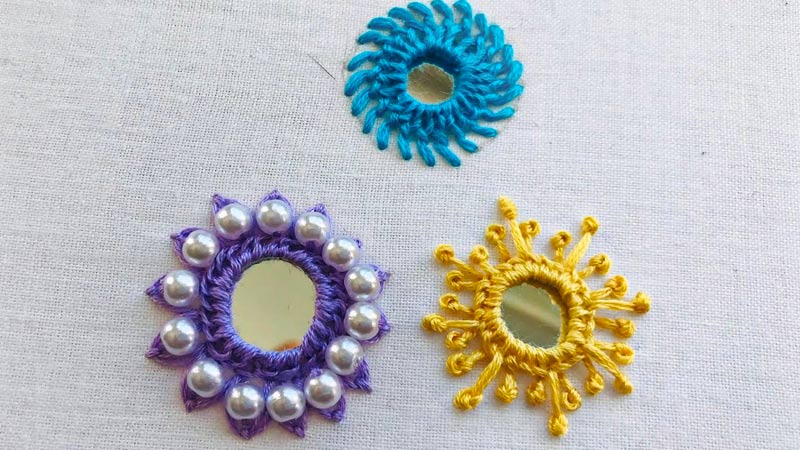
What Is Shisha Embroidery?
Shisha embroidery, or mirror work, is a traditional South Asian needlecraft incorporating small, reflective mirrors into the fabric.
Originating in India and Pakistan, this intricate art form involves securing mirrors onto the textile surface using various stitches like chain stitch or buttonhole stitch.
The mirrors, often embellished with colorful embroidery, create a dazzling effect, adding vibrancy to clothing, accessories, and home decor items.
Shisha embroidery holds cultural significance and is commonly used in traditional garments, especially during celebratory occasions. It exemplifies the rich heritage of South Asian craftsmanship and is cherished for its ornate beauty.
What Kind of Thread Is Used With Shisha Mirror Embroidery?
Shisha mirror embroidery, also known as mirror work or shisheh, is a traditional Indian and Pakistani embroidery technique that involves attaching small mirrors or reflective elements to fabric using various stitching methods.
The choice of thread plays a crucial role in ensuring the durability, aesthetic appeal, and overall success of shisha mirror embroidery. Embroiderers typically use various threads based on their project’s specific requirements.
The most commonly used threads for shisha mirror embroidery include:
Silk Thread
Silk threads are highly favored in shisha mirror embroidery for their exquisite qualities. Known for their smooth texture and natural sheen, silk threads impart a luxurious finish to the overall embroidery.
This particular characteristic complements the mirror work’s traditional and ornate nature, providing a touch of elegance to the fabric.
Silk threads are not only aesthetically pleasing but also contribute to the overall richness of the embroidered piece.
Cotton Thread
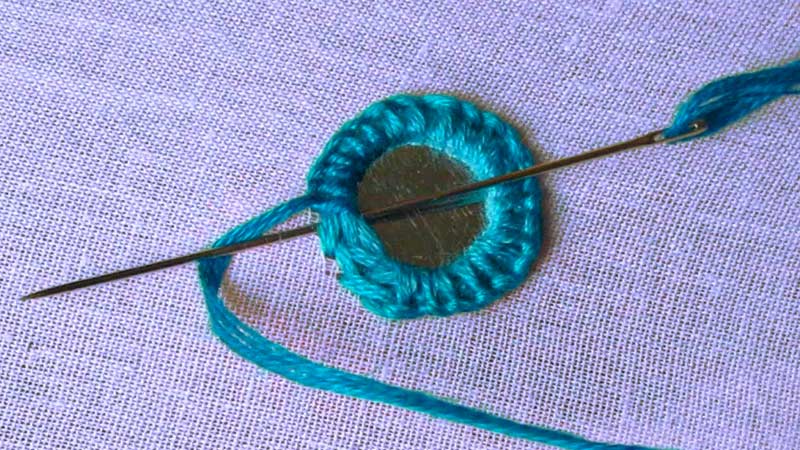
Cotton threads are a practical and widely embraced choice in shisha mirror embroidery. Renowned for their durability and ease of handling, cotton threads are versatile in adapting to different fabric weights and mirror sizes.
The availability of various thicknesses allows embroiderers to customize their approach based on the intricacy of the design.
Additionally, the natural feel of cotton threads enhances the tactile quality of the embroidery, making it a popular option for both novices and experienced embroiderers alike.
Metallic Thread
Metallic threads are an excellent choice for those seeking to infuse a hint of glamour into their shisha mirror embroidery.
Typically made from metallic-coated polyester or similar synthetic materials, these threads illuminate the mirrors.
The reflective nature of metallic threads enhances the brilliance of the mirrors, making them stand out in a visually captivating manner.
This choice is often preferred when aiming for a more opulent or festive appearance in the final embroidered piece.
Zari Thread
Zari, a thread crafted from metallic wire wrapped around a silk or cotton core, holds deep cultural significance in traditional Indian and Pakistani embroidery.
In the context of shisha mirror work, Zari threads contribute to a regal and celebratory aesthetic.
The intricate patterns created by Zari add a layer of sophistication to the embroidery, making it particularly suitable for ceremonial garments and special occasions.
Combining metallic shine and cultural tradition makes Zari appealing for those aiming for a traditional and opulent look.
Embroidery Floss
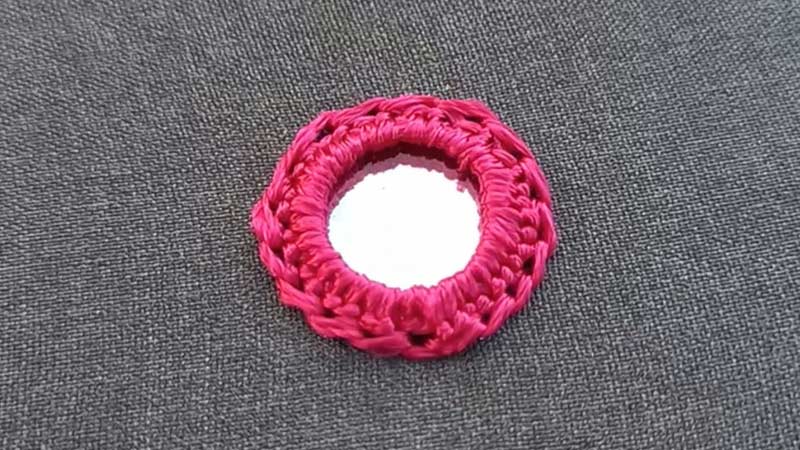
Embroidery floss, consisting of six strands of cotton thread, is a versatile option for shisha mirror embroidery.
Its ability to be separated into individual strands allows embroiderers to achieve varying thicknesses, catering to the demands of intricate and detailed stitching around the mirrors.
The wide range of colors available in embroidery floss enables artisans to experiment with different color combinations, adding depth and vibrancy to the overall design.
This flexibility makes embroidery floss a staple for achieving precision and artistic expression in mirror embroidery projects.
Monofilament Thread
When subtlety is the critical focus in showcasing the mirrors without drawing attention to the stitching, monofilament thread becomes an invaluable choice.
Transparent or translucent, this thread provides a nearly invisible finish, allowing the mirrors to take center stage. Monofilament thread is particularly advantageous when aiming for a seamless and delicate appearance.
Its ability to seamlessly blend into the fabric enhances the reflective qualities of the mirrors, creating an ethereal and captivating effect in the final embroidered piece.
Popular Shisha Embroidery Designs
Shisha embroidery, or mirror work or shisheh, is a traditional and vibrant form of needlework originating from South Asia, particularly India and Pakistan.
This art form involves attaching small mirrors or reflective elements to fabric using various stitching techniques.
Over the years, shisha embroidery has evolved, giving rise to many famous and intricate designs.
Here are some noteworthy and widely appreciated shisha embroidery designs:
Floral Patterns
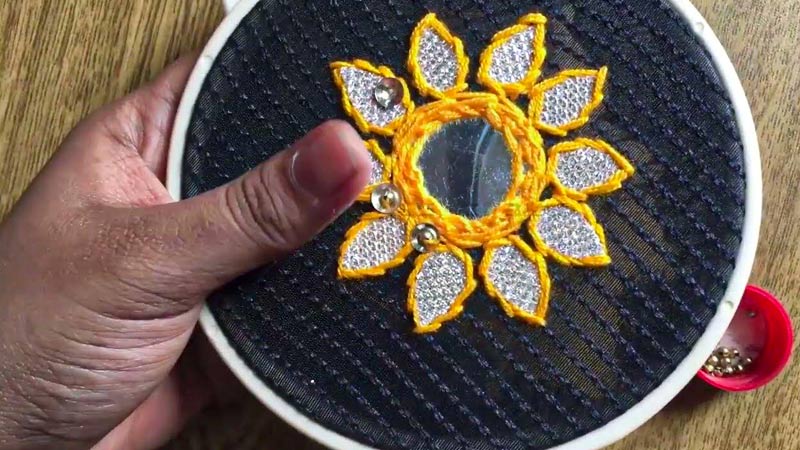
Floral patterns in shisha embroidery showcase the artistry of skilled artisans who deftly blend mirrors with intricate floral motifs.
These designs often depict delicate petals, leaves, and stems, creating a harmonious fusion of reflective surfaces and natural elements.
The versatility of floral patterns allows them to be adapted for a wide range of items, from garments like sarees and kurtas to home decor items like pillow covers and table runners.
The play between mirrors and floral designs adds a timeless and feminine touch to the embroidery, making it a beloved choice for traditional and contemporary applications.
Geometric Shapes
Geometric shapes bring a contemporary flair to shisha embroidery, introducing a modern twist to this traditional art form.
Circles, squares, triangles, and other geometric forms are thoughtfully combined to create visually appealing designs.
The juxtaposition of the clean, straight lines of geometric shapes with the reflective surfaces of mirrors adds a dynamic and striking element.
These versatile patterns lend themselves well to contemporary fashion, making them famous for modern garments, accessories, and eclectic home decor.
Peacock Motifs
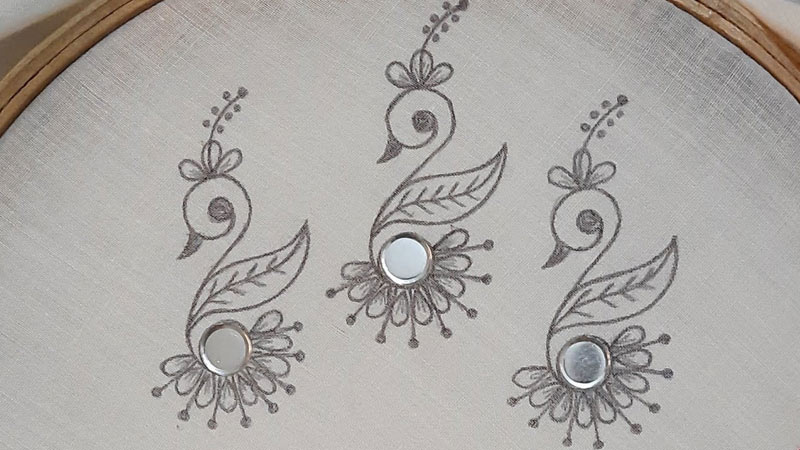
The peacock is revered in South Asian culture, symbolizing beauty and grace. Shisha embroidery often features peacock motifs where mirrors are strategically incorporated to emulate the dazzling plumage of this majestic bird.
These designs are favored for festive and celebratory occasions like weddings and cultural events.
The shimmering mirrors capture the essence of the peacock’s radiance, making these motifs a captivating and symbolic choice in shisha embroidery.
Traditional Borders
Traditional borders adorned with shisha mirrors are a timeless and classic choice in South Asian textiles.
These borders, commonly found on garments like sarees, dupattas, and salwar suits, showcase a perfect blend of mirrors and intricate border patterns.
The mirrors are often strategically placed within the border’s design, adding a touch of elegance and sophistication.
Whether adorning bridal wear or everyday clothing, traditional borders with shisha mirrors represent cultural richness and craftsmanship, adding a regal touch to the wearer’s ensemble.
Mughal-Inspired Designs
Mughal-inspired shisha embroidery designs pay homage to the opulence of the Mughal era, drawing inspiration from its art and architecture.
Intricate details, arabesque patterns, and symmetrical layouts are seamlessly combined with mirrors to create regal and majestic pieces.
These designs evoke a sense of historical grandeur, making them popular for special occasions and ceremonial garments.
Mughal-inspired shisha embroidery stands as a testament to the enduring influence of the rich cultural heritage of the Indian subcontinent.
Animal Motifs
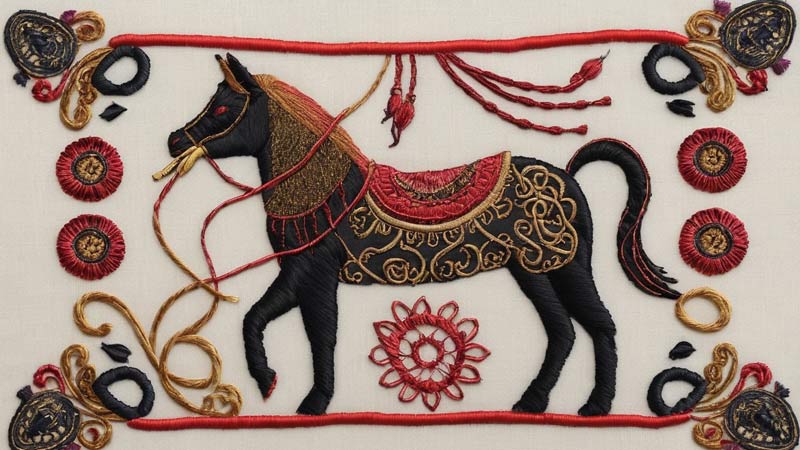
Animal motifs, especially elephants and peacocks, play a prominent role in shisha embroidery. Artisans strategically place mirrors to highlight specific features of these animals, adding a playful and whimsical touch to the overall design.
Elephants, symbolizing strength and wisdom, and peacocks, representing beauty and grace, become vibrant and captivating focal points in garments and accessories.
The incorporation of mirrors enhances the visual appeal, creating pieces that are stylish and carry symbolic significance, making them perfect for casual and festive occasions.
Tribal and Bohemian Designs
Shisha embroidery has seamlessly integrated into contemporary fashion with tribal and bohemian-inspired designs.
Mirrors become integral to free-spirited and eclectic patterns, offering a casual and laid-back aesthetic.
These designs often feature bold geometric shapes, abstract forms, and vibrant colors, making them popular choices for casual wear and accessories.
The fusion of mirrors with tribal and bohemian elements creates pieces that exude individuality and a carefree, artistic spirit, making them ideal for those seeking a unique and personalized fashion statement.
Religious and Spiritual Symbols
Shisha embroidery is a canvas for expressing religious and spiritual beliefs through carefully crafted designs featuring symbols like the Om, Swastika, or other culturally significant motifs.
Mirrors are meticulously integrated into these symbols, adding a sacred and meaningful element to the embroidery.
These designs hold cultural and spiritual significance, making them suitable for ceremonial garments and items of religious importance.
Shisha embroidery becomes a medium for expressing devotion and cultural identity, intertwining artistry with spirituality visually compellingly.
Mirror Mosaics
Some shisha embroidery designs transcend traditional patterns and take on a mosaic-like appearance. Mirrors are arranged in intricate patterns reminiscent of stained glass, creating visually stunning pieces.
These mirror mosaics often showcase the skill and precision of the embroiderer, requiring meticulous placement of mirrors to achieve a harmonious and dazzling effect.
The play of light on the reflective surfaces adds depth and dimension to the embroidery, transforming it into a captivating display of craftsmanship and artistry.
Contemporary Fusion Designs
Shisha embroidery undergoes creative fusion with other embroidery techniques and design elements in contemporary fashion.
Modern designers experiment with combining shisha mirrors with threadwork, beadwork, and other embellishments to create unique and innovative designs.
This fusion allows for diverse styles, from subtle and sophisticated to bold and avant-garde.
Shisha embroidery has become a dynamic and evolving art form, adapting to the ever-changing landscape of contemporary fashion while retaining its cultural and traditional roots.
How to Stitch Mirror on Cloth? Step-By-Step Guide

Stitching mirrors onto cloth, commonly known as shisha embroidery or mirror work, is a traditional and intricate technique that adds a touch of elegance and sparkle to the fabric.
Here’s a step-by-step guide on how to stitch mirrors on cloth:
Materials Needed:
- Fabric of your choice
- Mirrors in desired shapes and sizes
- Needle
- Thread (silk, cotton, metallic, or embroidery floss, depending on your preference)
- Embroidery hoop
- Scissors
- Marking tool (water-soluble pen or chalk)
- Backing fabric (optional for added stability)
Steps:
1. Prepare Your Fabric
Choosing a suitable fabric is crucial for the success of your mirror embroidery project. Opt for fabrics like cotton, silk, or heavier materials like denim or canvas, depending on your desired end-use.
Ensure the fabric is clean and free from any stains or debris. Iron the fabric to create a smooth and even surface, providing an ideal canvas for the mirror embellishments.
The fabric preparation sets the foundation for a polished and professional-looking final product.
2. Select Mirrors
The selection of mirrors plays a crucial role in determining the visual impact of your mirror embroidery. Choose mirrors in various shapes and sizes, aligning with your design vision.
Traditional shisha mirrors, often adorned with metallic frames, can add a layer of visual appeal.
Consider the overall aesthetic you want to achieve, whether it’s a symmetrical arrangement or a more eclectic mix of mirror shapes. The careful curation of mirrors enhances the artistic quality of your project.
3. Plan Your Design
Before diving into the stitching process, take the time to plan your design. Visualize the arrangement of mirrors on the fabric and sketch the design directly onto the surface using a water-soluble pen or chalk.
This planning step helps you map out the placement of mirrors, ensuring symmetry and even distribution across the fabric.
It serves as a roadmap for the embroidery process, allowing for a smoother execution of your envisioned design.
4. Prepare the Mirrors
To enhance safety and comfort during the stitching process, take a moment to prepare the mirrors. If the mirrors have sharp edges, wrap them with a thin, strong thread.
This not only protects your fingers from potential injuries but also creates a secure border around each mirror. The wrapping process can add a decorative touch, contributing to the overall aesthetic of the mirrors.
Careful preparation of the mirrors ensures a smoother stitching experience and a polished final appearance.
5. Secure the Fabric in an Embroidery Hoop
Stabilizing the fabric in an embroidery hoop is a practical step that significantly aids the stitching process. It keeps the fabric taut and prevents it from shifting, allowing for more precise and controlled stitching.
The even tension created by the hoop ensures that the mirrors lie flat on the fabric, promoting a neat and professional finish.
The embroidery hoop is a valuable tool in maintaining the integrity of your design, making the entire process more manageable and enjoyable.
6. Begin Stitching:
With your fabric prepared and mirrors in place, it’s time to start stitching. Thread your needle with the chosen thread, ensuring a secure knot at the end.
To attach a mirror, bring the needle up from the back of the fabric to the front, positioning it at the mirror’s center.
Holding the mirror in place with your fingers, make tiny stitches around the mirror’s border.
This step is crucial for securing the mirror to the fabric. Experiment with various stitches, such as the straight stitch for simplicity, the blanket stitch for a cozy border, or the chain stitch for a decorative and secure edge.
7. Stitching Techniques
- Straight Stitch: Pass the needle through the fabric and around the mirror in a straight line. This creates a neat, straightforward border, ideal for a clean and modern look.
- Blanket Stitch: Create a series of tiny stitches along the mirror’s edge, forming a border that resembles a blanket. The blanket stitch is a popular choice for securing mirrors in shisha embroidery due to its decorative yet functional nature.
- Chain Stitch: Form a continuous chain of stitches around the mirror to provide a decorative and secure edge. The chain stitch allows for creativity and adds an ornate touch to the mirrors.
8. Continue Adding Mirrors
As you progress, continue the stitching process for each mirror, adhering to your predetermined design. Pay attention to spacing and alignment, ensuring a balanced and cohesive appearance.
The repetition of the stitching process adds rhythm and consistency to the project, creating a harmonious integration of mirrors into the fabric.
9. Finishing Touches
Once all mirrors are securely stitched, tie off the thread on the back of the fabric and trim any excess. This step ensures a tidy and polished appearance.
If desired, add embellishments or embroidery around the mirrors to enhance the overall design. This personal touch allows you to customize the piece according to your artistic preferences.
10. Secure the Back
If the back of your fabric is visible, take the extra step of adding a backing fabric. This covers the stitches and knots, providing a clean and finished appearance.
The backing fabric not only adds aesthetic value but also contributes to the durability of the embroidered piece.
11. Final Pressing
To complete the process, gently press the embroidered fabric using a pressing cloth. This helps remove any wrinkles and sets the stitches in place.
The final pressing enhances the overall presentation of the shisha embroidery, ensuring a professionally finished and visually appealing result.
FAQs
What type of needle is used for Shisha Mirror Embroidery?
For Shisha Mirror Embroidery, it is recommended to use a sharp embroidery needle with a thin, pointed tip.
What type of fabric is commonly used for Shisha Mirror Embroidery?
Depending on the desired outcome, various fabrics can be used for Shisha Mirror Embroidery.
Common choices include cotton and silk for smooth surfaces, but heavier fabrics like denim or canvas can also be employed for a more robust look.
What type of mirror is used for Shisha Mirror Embroidery?
Traditional Shisha mirrors are often used, characterized by small round mirrors with a metallic frame around them. These mirrors add a decorative touch to the embroidery.
To Recap
The choice of thread in Shisha Mirror Embroidery is a critical factor influencing the aesthetic appeal and durability of the final piece.
Silk threads, renowned for their smooth texture and luxurious sheen, complement the traditional elegance of mirror work.
Cotton threads offer durability and versatility, adapting to various fabric weights. Metallic threads introduce a glamorous touch, enhancing the reflective quality of mirrors.
Zari threads, rooted in cultural tradition, bring a regal and festive element to Shisha embroidery. The flexibility of embroidery floss allows for intricate stitching, while monofilament threads provide an almost invisible finish, emphasizing the mirrors.
The selection of thread becomes an artful decision, contributing to the overall beauty of Shisha Mirror Embroidery.
Leave a Reply